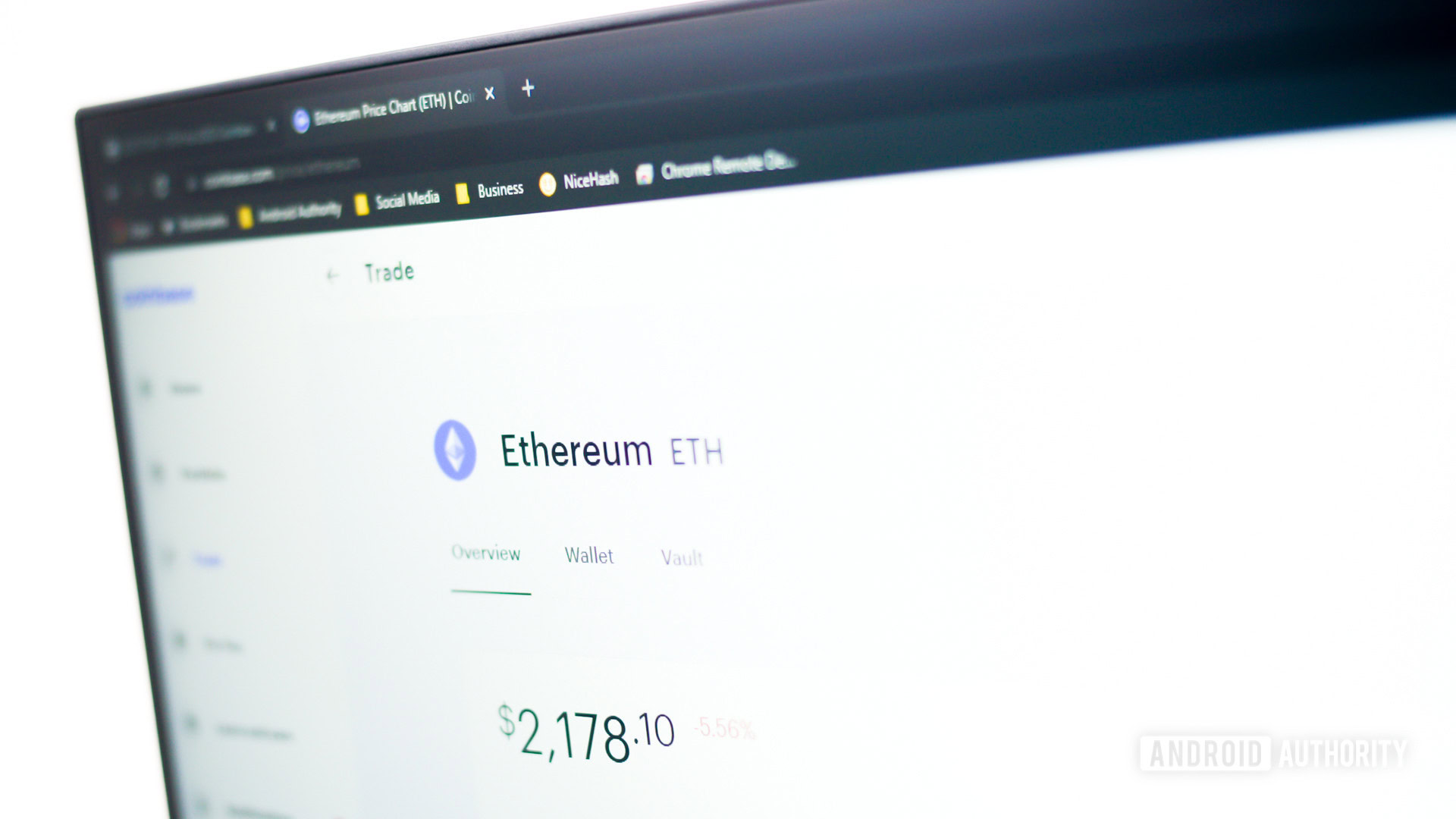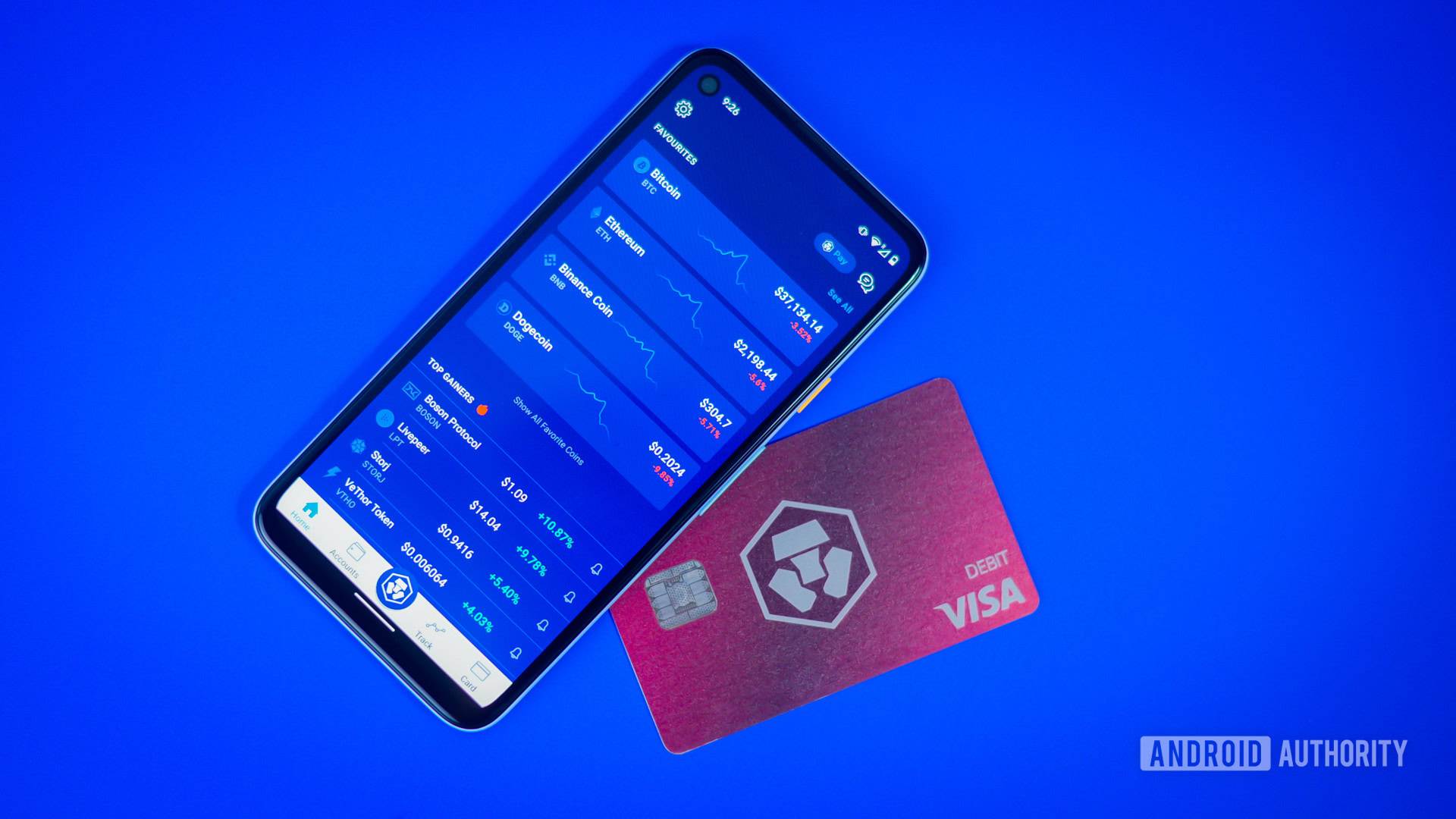Affiliate links on Android Authority may earn us a commission. Learn more.
What is Ethereum? Here’s everything you need to know
July 24, 2021

Ethereum has reigned supreme as the second-largest cryptocurrency by market capitalization for several years now. Since its release in 2015, it has promised disruption in several industries, ranging from financial services to supply chain management. Ethereum has also revolutionized the startup crowdfunding landscape, as demonstrated by single-handedly enabling the Initial Coin Offering (ICO) boom of 2017.
Unlike Bitcoin, Ethereum is not designed for the singular purpose of wealth transfer or serving as a store of value asset. Instead, it was the first to implement the concepts of smart contracts and decentralized applications. Ethereum is designed to eliminate mediators and intermediaries from just about any service you can think of — including lending, advertising, and property ownership, to name a few.
Let’s take a comprehensive look at how the underlying technology works and why the cryptocurrency community thinks it may be worth a trillion dollars or more someday.
See also: The best crypto wallets for Android
Understanding the basics
Cryptocurrencies are a relatively new technology. To that end, here are a few terms and phrases that you may come across while reading this article:
Altcoins: An altcoin is simply a colloquial or informal term for cryptocurrencies other than Bitcoin. Usage of this term has somewhat diminished in recent years. However, you may still find many in the cryptocurrency community refer to ETH and other tokens as altcoins.
Layer-2 scaling solutions: As the name suggests, second layer or layer-2 scaling solutions offer an alternative approach to boost a cryptocurrency network’s transaction capacity. In a nutshell, they move transactions off the main ledger and onto a secondary network, which is much more economical and faster. This is usually achieved at the expense of security or decentralization but can be useful anyway for small, everyday payments.
Consensus: Cryptocurrencies such as Ethereum are essentially a shared ledger spread across computers globally. In the absence of a central authority, new transactions added to this ledger must be vetted for accuracy and validity. To ensure that only legitimate transactions are recorded, a consensus mechanism or algorithm is typically used to ensure the decision-making process is fair and inclusive.
What is Ethereum, and how does it differ from Bitcoin?

Like the vast majority of cryptocurrencies on the market today, Ethereum is based on blockchain technology. Just like how traditional currencies differ from each other in terms of money supply and monetary policy, no two blockchain-based cryptocurrencies are ever quite the same. The vital underpinnings of blockchain technology are all present, though — Ethereum is decentralized and trustless, just like Bitcoin.
Ethereum extended Bitcoin’s vision to decentralize the world of finance by proposing the concept of programmable contracts. Often referred to as smart contracts, these are essentially a digital agreement between two parties that is every bit as binding as a legal contract on paper.
In our day-to-day life, traditional digital contracts are omnipresent but limited in scope. For one, neither party usually has a method of enforcing the terms of the agreement. Non-compliance cannot be penalized either unless you choose to approach a mediating authority like a court.’
Smart contracts are one of the core benefits to Ethereum over other cryptocurrencies.
Ethereum-based smart contracts fix both these issues, all in a completely automated way. While Bitcoin can execute simple, smart contracts via multi-signature wallets, Ethereum’s implementation is far more powerful and robust.
Under the hood, a smart contract is actually just a piece of code that lives on the Ethereum blockchain. The code essentially looks like this: “If X happens, do Y.” Once signed by both parties, the contract is irrevocable. Blockchains are immutable and tamper-resistant, which means transactions cannot be modified once recorded. By extension, this also prevents one party from changing the terms of the contract for self-gain.
You may wonder how Ethereum solves the problem of non-compliance in digital agreements without any intermediaries or third-party intervention. The answer is pretty straightforward — you attach a monetary value to the contract in the form of ether (ticker ETH), Ethereum’s native cryptocurrency.
For instance, in the supply chain industry, a smart contract could be used to initiate a payment automatically upon receiving a shipment of goods. Another example would be an online betting or prediction platform, which can automatically and transparently dispense funds to the winner as soon as the match’s outcome is decided.
Such use-cases usually involve a bundle of smart contracts designed to work in tandem and an external oracle to know when real-world events have occurred. Without going too deep into the specifics, know that these smart contract bundles are often referred to as decentralized applications in the cryptocurrency industry.
On that note, let’s explore how Ethereum promises to or has already revolutionized various services and industries.
Decentralized Apps (dapps): The future of the Internet?

We entrust intermediaries and third parties with our data and money with seemingly every action on the Internet. Even the simple act of watching a YouTube video, for example, involves Google acting as the middleman for dispensing ads to viewers and payments to creators. In an ideal world, this relationship would be frictionless. However, accusations of bias and censorship against internet companies are commonplace these days. This has left many to question if intermediaries have too much control and power over our lives.
Decentralized applications aim to fix this problem by eliminating third parties and replacing them with transparent contracts on a blockchain. Take cryptocurrency exchanges, for instance.
Similar to a stockbroker, these platforms allow you to exchange one digital asset for another. However, many of them have lost user funds to hacks over the years, with lackluster security practices likely to blame. What’s more, they often charge exorbitant fees to deposit, trade, and withdraw cryptocurrency.
Uniswap, a popular Ethereum-based dapp, is a platform that uses smart contracts to establish the same functionality as a traditional crypto exchange minus the middleman. This means you no longer have to entrust your funds to a centralized custodian.
When you’re ready to make a trade on Uniswap, all you need to do is initiate a transfer to the provided address. Then, a smart contract will automatically release the other side of the trade. As long as the contract’s code is robust and trustworthy, the chances of you losing money is non-existent.
Ethereum dapps are also permissionless. The absence of a middleman means that no one can control or censor your transactions for any reason. In contrast, a traditional app developer or company could shut down your account or go bankrupt overnight — leaving you in limbo.
It’s worth noting, however, that not all decentralized applications or smart contracts are transparent and trustworthy. In fact, the phrase smart contract refers to the fact that the code lives on the Ethereum blockchain as machine-readable bytecode. The latter is an important distinction because the onus is on the developer to write bug-free code and later open it to audits from the community. If a project or contract is relatively unknown, you cannot trust it — just like with any other kind of app.
ERC-20 Tokens: Lowering the barrier for token development
Notably, developers can also create their own tokens on top of the Ethereum blockchain to complement their decentralized application. This means that developers of small applications don’t have to deal with the complexities of creating and securing their own decentralized network.
These tokens each have their own unique name, price, and distribution model. However, they are fundamentally smart contracts recorded on the Ethereum blockchain. The specification for such tokens was standardized back in November 2015, under the title ERC-20 (Ethereum Request for Comment 20). The name is simply a reference to the way Ethereum handles feature proposals from the public.
The Brave web browser is a popular example of this concept in action. On the surface, Brave looks like just another web browser. Look closer, however, and you’ll find that it also includes a decentralized advertisement platform that rivals incumbents such as Google in terms of transparency, security, and privacy.
Instead of monetizing data, Brave has advertisers pay users directly for opting-in to receive advertisements. Users can then tip content creators across various websites to support their work. The idea is to eliminate data exploitation and establish a healthy relationship between advertisers, content creators, and users. An ERC-20 token, called the Basic Attention Token (BAT), facilitates these payments.
Given that the entire system relies on smart contracts, Brave, the company, does not control transactions or have any role in the BAT payment process. The contracts are indeed designed to award a commission to the developers, but other than that, the system is technically unbiased and free of human intervention.
Read more: Should you make the switch to Brave Browser?
Hundreds of such decentralized applications already exist, and this number is only expected to grow in the future. Furthermore, a surprising number of cryptocurrencies currently on the market are actually based on Ethereum. Some popular examples include USD Tether (ticker USDT), Uniswap (UNI), Dai (DAI), and Polygon (MATIC).
In addition to offering a lower barrier to entry, Ethereum-based tokens can be used as a crowdfunding tool. Brave Browser, for example, raised a staggering $35 million through an Initial Coin Offering, which is the cryptocurrency analog to Initial Public Offerings (IPOs) in traditional finance.
ICOs are essentially token sales wherein the developers offer investors the chance to purchase tokens before a debut on the open market. Cryptocurrency and blockchain startups have raised billions of dollars through such crowdfunding events. However, the vast majority of these enterprises have failed or gone bankrupt over the years — so do your due diligence before investing in one.
NFTs: Ethereum’s killer app or yet another crypto fad?
Non-fungible tokens or NFTs are perhaps the single most well-known application of Ethereum’s smart contracts.
Put simply, an NFT is a unique and non-interchangeable token that can be used to prove ownership of a particular object or item. A popular application of this technology is the NBA Top Shot marketplace, where digital collectibles featuring top NBA highlights are auctioned away. Here, the highest bidder receives a unique cryptographic token, which they can then store in their Ethereum wallet or sell to another collector.
This is in contrast to most cryptocurrency tokens, which can be used interchangeably. Banknotes and coins are also examples of fungible assets since every unit is valued the same. There is also no practical reason to distinguish two different bitcoins, for example.
Whether or not NFTs are here to stay, it’s clear that they are driving adoption and interest in Ethereum.
Think of NFTs as the digital equivalent to Pokémon trading cards. Each one can have a different rarity or underlying value, meaning that prices are never static or similar across the board.
Even though NFTs were propelled to mainstream popularity in 2021, it has always been a valid application of the technology. In fact, this wasn’t even the first time NFTs witnessed widespread demand and appeal.
In 2017, the virtual collectible platform CryptoKitties almost single-handedly bogged down the entire Ethereum network with its popularity. Back then, the NFT market was worth just over a million dollars. While significant at the time, it has become normal for a single tweet to sell for $3 million in 2021.
Whether or not NFTs are here to stay, it’s clear that they are driving adoption and interest in Ethereum. NFTs may also move away from digital collectibles and facilitate real-world transactions involving art in the long term.
Imagine a future where collectors can hold the rights to a painting as a token on the Ethereum blockchain. This way, even if the art piece is stored and displayed in a museum, collectors can trade it amongst themselves or even band together to own a portion of it.
NFTs could also be used to signal ownership of other kinds of property. Using a tokenized system for real estate, for instance, would help bring down the cost of transferring rights. Mortgages would also become far more streamlined. If every detail related to the property is recorded on a trustworthy blockchain, lenders will hopefully no longer have to employ extensive vetting and verification processes — lowering costs and wait times for all involved parties.
Ethereum 2.0: Ending the blockchain scalability debate

As mentioned above, Ethereum has succumbed to network congestion on more than one occasion over the past few years. During these periods, users are forced to wait several days for their transactions to process or pay exorbitant fees to jump the queue. Naturally, this is an untenable situation for a platform that aspires to be the ‘world computer.’
Like many early cryptocurrencies, the Ethereum network has limited capacity for transactions. At the time of its release, most digital currencies — including Bitcoin — relied on the Proof of Work algorithm to achieve network consensus. While extremely secure, this approach came at the cost of scalability, limiting most digital currencies to a paltry 10-20 transactions per second.
For years, researchers attempted to find a solution that would improve transaction throughput without sacrificing the core tenets of security and decentralization. By 2017, Ethereum’s developers finally settled on the Proof of Stake consensus mechanism. This kicked off one of the largest network upgrade cycles the cryptocurrency world has ever seen.
Dubbed Ethereum 2.0 or simply ‘Serenity,’ the network upgrade is slated to improve scalability by introducing a number of key changes to the way transactions are verified on the network. Additionally, the network will also implement sharding — allowing the blockchain to be split up into tiny chunks, called ‘shards,’ to improve overall transaction capacity.
All in all, Ethereum developers estimate that the upgrade will bring down fees by a significant amount, especially when combined with upcoming various layer-2 scaling solutions such as Optimism. Ethereum co-founder Vitalik Buterin has stated that the cryptocurrency could handle as many as 100,000 transactions per second (TPS), but only once the upgrade nears completion.
ETH2 scaling for data will be available *before* ETH2 scaling for general computation. This implies that rollups will be the dominant scaling paradigm for at least a couple of years: first ~2-3k TPS with eth1 as data layer, then ~100k TPS with eth2 (phase 1). Adjust accordingly.— vitalik.eth (@VitalikButerin) June 30, 2020
This is an important distinction because Ethereum’s transaction capacity will likely not increase overnight. After all, ETH 2.0 has been a multi-year journey for the cryptocurrency community. While the first phase of this network upgrade was implemented in December 2020, the timeline for the final phase is still uncertain. Nonetheless, estimates range from early 2022 to late 2023.
What is Proof of Stake (PoS)? Is it as secure as Bitcoin’s Proof of Work?
In our article on Bitcoin, we explained how the Proof of Work consensus mechanism uses computational power from miners worldwide to keep the network honest. However, the problem with this approach is that Bitcoin miners are now some of the largest electricity consumers in the world. This has led to widespread criticism over Bitcoin’s supposed carbon footprint.
While Ethereum also started as a Proof of Work-based network, its developers have now zeroed in on the Proof of Stake algorithm. But how do the two approaches differ from each other?
Put simply, Proof of Stake completely does away with the concept of mining. Instead, individual transactions are voted on by validators, who are volunteers, and chosen at random. A user needs to deposit a minimum amount of 32 ETH to become a validator. This amount, also known as a ‘stake,’ is then held in an escrow to hold them accountable.
For each transaction, votes from different validators across the network are compared. Votes are weighted based on the validator’s stake. Proof of Stake logic assumes that large stakeholders are more trustworthy and, consequently, more likely to enforce the rules of the network.
If a validator tries to vote against the grain, a portion of their stake is immediately deducted for attempting to attack the network. After a few such instances, that dishonest validator will be “slashed” and ejected from the staking process.
Since the Proof of Stake system is far less arbitrary than solving complex cryptographic puzzles as in Proof of Work, it requires a fraction of the computing power. This is why ETH 2.0 is expected to massively improve transaction throughput, reduce wait times, and lower fees.
As for security and decentralization, Ethereum’s developers remain confident that no significant sacrifices will be made. However, some in the cryptocurrency community point out that the 32 ETH minimum for staking introduces a rather high bar for entry. Before ETH 2.0, participating in Ethereum’s transaction validation process only requires dedicating a few graphics cards to the cause.
Obtaining and locking in 32 ETH, on the other hand, could cost over $100,000 — depending on the price of ether at the time. You could pool your funds with other individuals to create a staking pool, but that involves using a third-party intermediary. This could theoretically lead to centralization since the process favors and rewards the richest.
Despite these perceived drawbacks, though, the Ethereum community is confident that the advantages of Proof of Stake far outweigh the cons.
Ethereum alternatives worth considering

If Ethereum is too broad for your cryptocurrency needs, it’s worth noting that several competing cryptocurrencies exist. Some strong alternatives to consider include the following:
Bitcoin: Unlike Ethereum, Bitcoin is far more monolithic and stable in terms of feature development. It is also a more mature platform, having existed for over a decade. To that end, there is less uncertainty to grapple with, especially if you’re skeptical about ETH 2.0.
Cardano: If you’re looking for a platform that can already achieve low transaction fees, Cardano is a strong contender. With smart contract functionality expected to finally arrive in the near future, it is one of the most hyped cryptocurrencies on the market. Do note, however, that it does not have Ethereum’s early mover advantage.
Polkadot: Polkadot is yet another platform dedicated to creating decentralized applications. Instead of relying on smart contracts, though, Polkadot allows developers to create their own blockchains to communicate with each other. This is somewhat reminiscent of ETH 2.0’s sharding.
Buying Ethereum: What you need to know

Ethereum offers a unique proposition with its support for decentralized applications and smart contracts. However, it is no longer the only blockchain platform that supports smart contracts and decentralized applications. Some notable rivals include Tron (TRX), the Binance Smart Chain (BSC), and eventually, Cardano (ADA).
Furthermore, Ethereum is on the cusp of one of the largest network upgrades the world has ever seen. If successful, ETH 2.0 will lower transaction settlement times and fees for users and eliminate the common complaint of high energy usage due to crypto mining.
A lot can go wrong during a large-scale network upgrade, though, so know that there is some risk to being an early adopter. Still, with full-fledged applications like the aforementioned Brave Browser and Uniswap, Ethereum is easily the most functional platform today. In contrast, its competitors either haven’t yet implemented smart contract functionality or have a fraction of the user base.
All this is to say that Ethereum is a solid value proposition in the eyes of many cryptocurrency enthusiasts and investors. If you believe that smart contracts, decentralized applications, and NFTs are inevitable, you may even consider Ethereum to be undervalued at its current price levels.
As with any cryptocurrency purchase, however, be wary that the market is highly volatile, and you may have to keep a longer investment horizon. If you’ve already swallowed that pill, though, Ethereum seems like a safe bet — especially when you consider how many cryptocurrencies are actually ERC-20 tokens that would simply not exist without the underlying ETH blockchain.
See also: The best cryptocurrency apps for Android
Frequently Asked Questions
Q: What is gas in the context of Ethereum transactions?
A: The Ethereum network relies on a system of incentives to keep transaction validators honest. To that end, every transaction you initiate needs to include a non-zero fee to compensate for the validator’s efforts.
Per the official Ethereum documentation, “Gas refers to the unit that measures the amount of computational effort required to execute specific operations on the Ethereum network.” Gas prices are often quoted in gwei, where one gwei is 0.000000001 ETH.
Q: How much can I expect to pay in transaction fees?
A: As with most other cryptocurrencies, Ethereum gas prices depend on many factors. While network congestion would seem like the most obvious place to look, keep in mind that transactions involving smart contracts have more data and can be more expensive than a pure Ethereum transfer.
Either way, check Etherscan’s live gas tracker to ensure you’re setting the right fee amount. Gas prices below 30 Gwei are considered low, while 100 or higher are common during high user activity periods.
Q: How does Ethereum mining differ from Bitcoin? Can I mine ETH on my gaming PC?
A: Unlike Bitcoin, Ethereum can be mined using graphics cards found in a typical gaming PC. In fact, the use of consumer-grade hardware for cryptocurrency mining was the root cause of computer component shortages in 2017 and again in 2021.
Ethereum mining, however, will not last very long. With ETH 2.0 expected to land in late 2022, mining will be a thing of the past. If you’re still keen on making hay while the sun shines, check WhatToMine to calculate profitability and the documentation for the open-source PhoenixMiner software.
Thank you for being part of our community. Read our Comment Policy before posting.